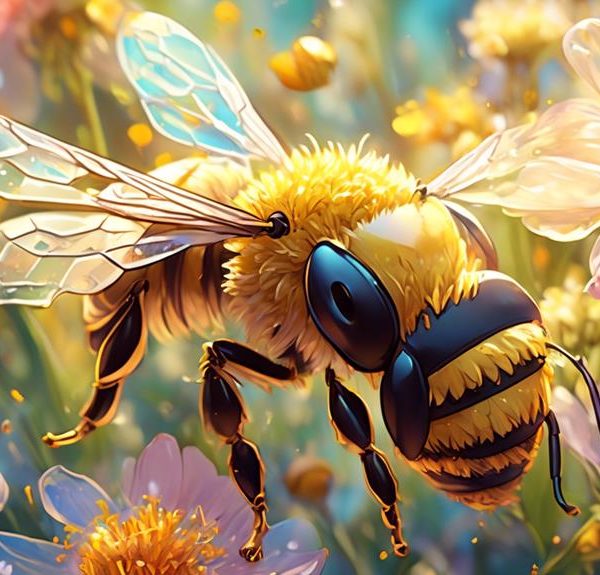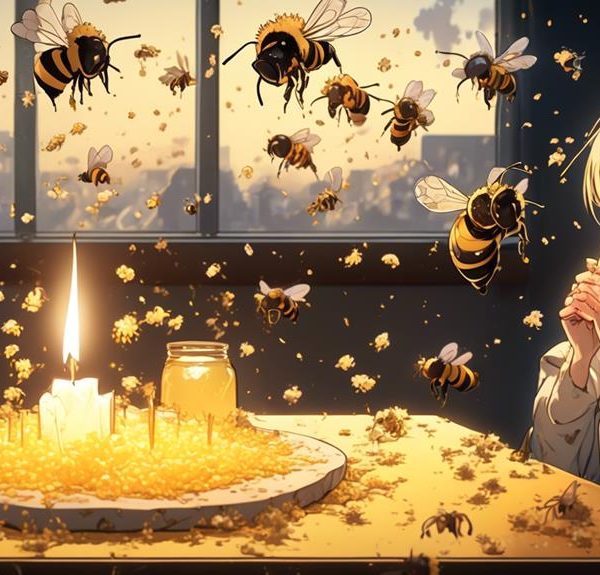Immerse yourself in the intriguing world of the all-black Carpenter Bee, an unsung hero of our ecosystem with a mysterious twist in its tale.
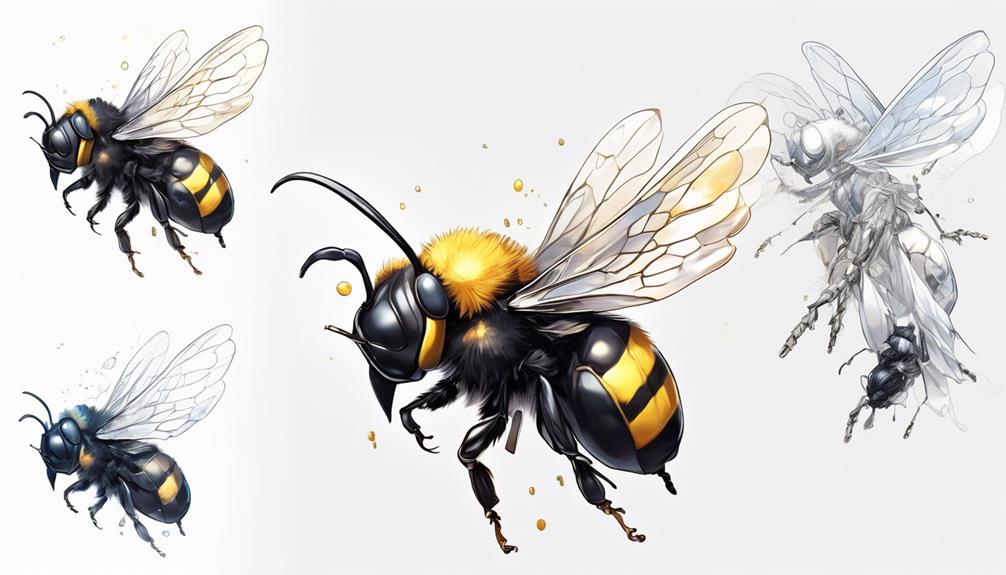
What Bee Is All Black?
You might have noticed a rather unconventional guest bumbling about your garden, a bee that's ditched the familiar yellow and black attire for a sleek, all-black ensemble. This is the carpenter bee, a solitary insect with a penchant for burrowing into your wooden structures.
While they might not be the most welcome of visitors, there's more to these ebony pollinators than meets the eye. As we unravel the mysterious world of these all-black bees, you'll discover how vital they are to our ecosystem and why their preservation is crucial.
But don't get too comfortable, there's an unexpected twist to their tale.
Key Takeaways
- The black bee has an all-black body, compact size, and sparse hairs.
- Carpenter bees have a solitary lifestyle and burrow into wood to lay eggs.
- Black bees are found in various ecosystems worldwide and are threatened by habitat destruction and climate change.
- Black bees play a pivotal role in pollination, promoting biodiversity and healthy ecosystems.
Identifying the All-Black Bee
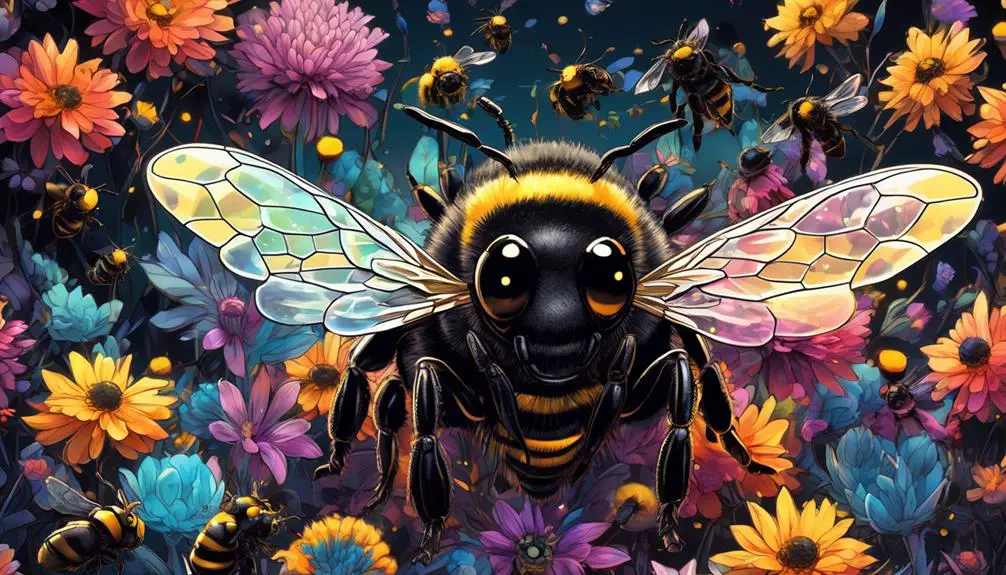
To accurately identify the all-black bee, you'll need to observe its key distinguishing characteristics closely, focusing on its entirely black body, compact size, and distinctive behavior.
Unlike other bees with varying colored stripes or patches, the all-black bee is monochromatic. It's a sight to behold, especially under the microscope where its fine, short, and sparse hairs appear more visible against the glossy, dark exoskeleton.
The size of the all-black bee is another crucial identification marker. You'll notice it's smaller, roughly the size of a common housefly, which is significantly compact compared to other bee species. It's easy to mistake it for a fly or a wasp due to its size, but its behavior gives it away.
The all-black bee exhibits unique behavior, particularly in its flight pattern and feeding habits. It's more direct in its flight, almost bullet-like, unlike the more zigzag or meandering flight of other bees. Additionally, it's a solitary bee and prefers nectar-rich flowers, unlike social bees that are attracted to a wider range of flowering plants.
Understanding these distinctive features will help you correctly identify this fascinating creature.
Understanding Carpenter Bee Behavior
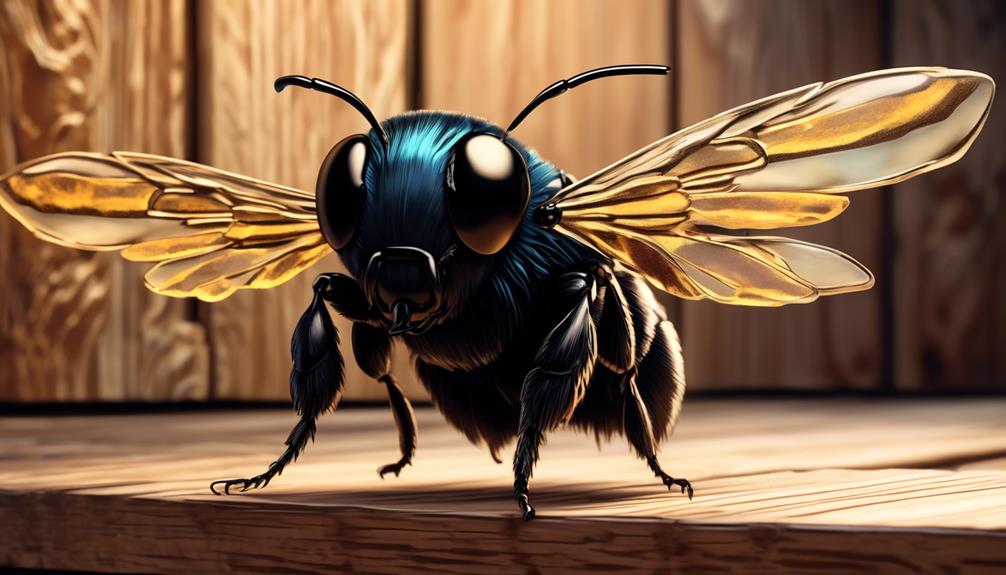
Diving into the world of carpenter bees, you'll find their behavior to be remarkably distinctive and intriguing, shaped by their solitary lifestyle and wood-boring habits. Unlike social bees, they don't live in hives. Instead, each female carpenter bee burrows into wood to lay her eggs, creating a series of tunnels and chambers.
You might wonder about their diet. Carpenter bees, despite their name, don't eat wood. They bore holes for their nests, but they feed on nectar and pollen. Their long tongues allow them to access deep flowers, making them efficient pollinators.
Their mating behavior is also worth noting. Males, while unable to sting, are territorial. They'll often fly near people or animals, acting aggressive to protect their territory. However, it's all a bluff; their aggression doesn't lead to stinging.
Carpenter bees' behavior is driven by survival and reproduction, like other insects. But their solitary, wood-boring lifestyle sets them apart. Understanding their behavior helps us appreciate their role in the ecosystem and manage them in our surroundings. Their behavior is a testament to nature's diverse adaptations.
Habitat and Distribution of Black Bees
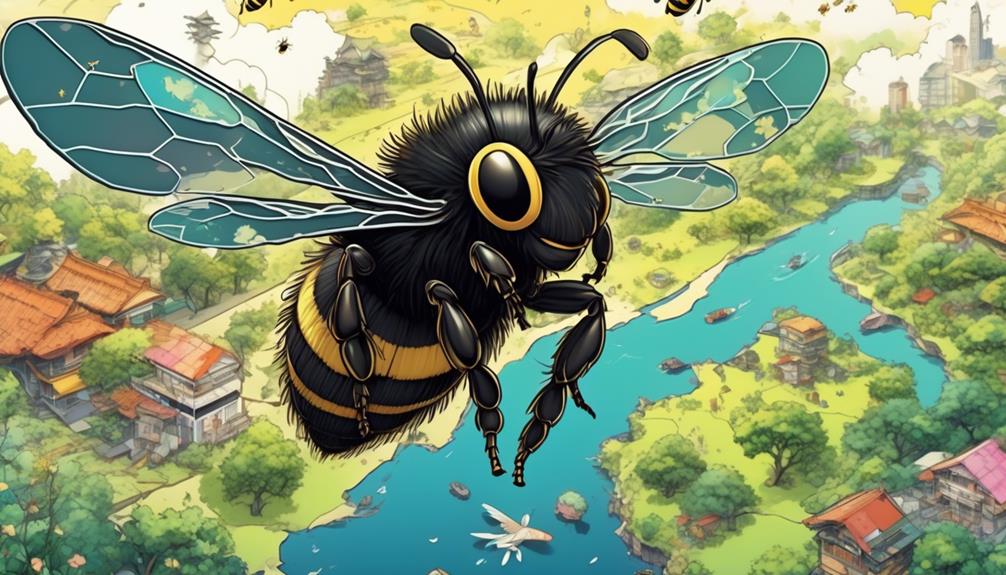
When it comes to understanding the habitat and distribution of black bees, you'll find them scattered across various ecosystems, thriving in diverse environments worldwide. These bees, specifically the Carpenter variety, are prevalent in North America, stretching from Canada to Mexico. They're not choosy about their homes; they'll burrow into both soft and hard woods, often causing structural damage.
In Europe, you'll encounter the European Dark Bee, often found in forested regions. They're adapted to cold climates, often surviving harsh winters that other bees can't withstand. They typically set up shop in tree cavities or artificial hives provided by beekeepers.
Down under in Australia, the native stingless bee is entirely black. They're found in warm tropical climates, often nesting in tree trunks or within rock crevices.
However, it's important to note that habitat destruction, climate change, and pesticide exposure are threatening these black bee populations. So, while you'll find them in a diversified range of habitats, their survival isn't guaranteed. As such, understanding their distribution can aid in effective conservation strategies, ensuring these black bees continue to play their crucial role in our ecosystems.
Role in Pollination and Ecosystem
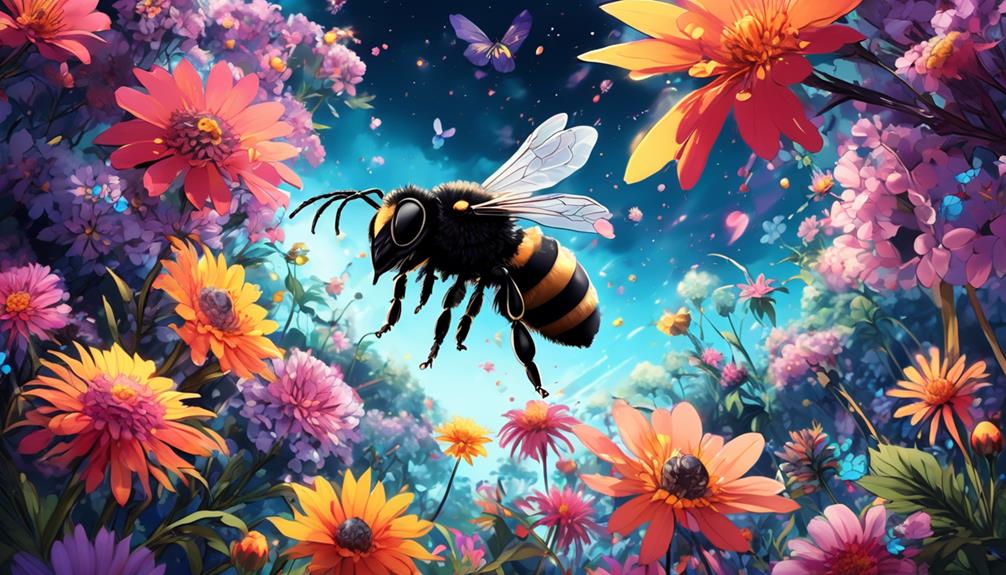
In the grand scheme of ecosystems, black bees play a pivotal role, particularly in pollination, contributing significantly to the reproduction of various plant species. By transferring pollen from the male parts of a flower to the female parts, they facilitate fertilization. This leads to the production of fruits and seeds, which are essential for the survival of numerous plant species.
Here's a detailed table illustrating the process:
Stage | Role of Black Bee | Outcome |
|---|---|---|
Pollen Pick-Up | Bee collects pollen from male flower parts | Pollen sticks to bee's body |
Transfer | Bee visits another flower for nectar | Pollen rubs off onto female flower parts |
Fertilization | Pollen fertilizes ovule | Seed and fruit development begins |
They also contribute to biodiversity, ensuring healthy ecosystems by promoting the growth of a variety of plants. You'll find that black bees play an integral part in the food chain too. They provide food for small insects, birds, and mammals. Therefore, their existence plays a critical role in maintaining the balance of our ecosystem.
Dealing With Carpenter Bees Safely
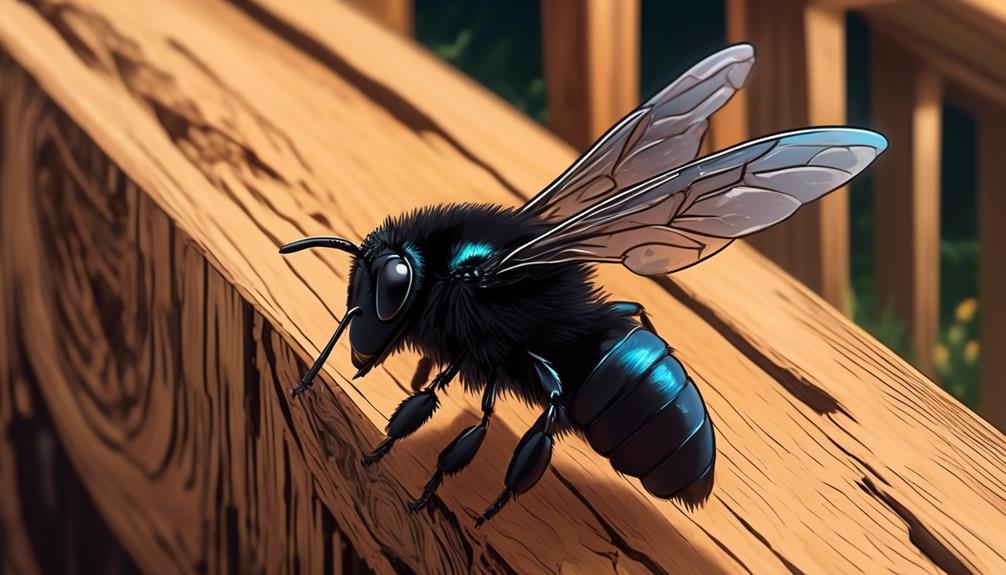
Navigating the world of carpenter bees, it's essential to understand how to deal with them safely and effectively. In contrast to common misconceptions, these all-black insects aren't typically aggressive. However, they can cause structural damage to your property as they burrow into wood to lay their eggs.
Their tendency to return to the same locations year after year can lead to extensive damage if left unaddressed. It's crucial to identify an infestation early. Look out for perfectly round holes on wooden surfaces and sawdust, indicating carpenter bee activity.
Using an insecticidal dust in these holes can be an effective method of eliminating the problem. It's crucial, however, to wear protective clothing to avoid any potential stings. Once the bees and larvae are dead, plug the holes with wood putty to discourage future infestations.
If the infestation is severe, you might need professional help. Exterminators can safely and efficiently eliminate the bees and their nests, reducing the risk of structural damage.
Frequently Asked Questions
What Is the Lifespan of an All-Black Bee?
You're curious about the lifespan of a specific bee, aren't you?
The Carpenter bee, known for its all-black appearance, typically lives for about one year.
It's a fascinating creature, spending most of its life as a larva during winter and emerging in the spring as an adult.
These adults then mate and die in late summer, starting the cycle over again.
It's an intricate process, demonstrating nature's fine-tuned balance.
What Predators Do All-Black Bees Have in Their Natural Habitat?
You're asking about the predators of a specific type of bee, the all-black one. In their natural habitat, these bees face threats from various species.
Birds, especially bee-eaters, are their primary predators. Other insects like spiders and dragonflies also pose a risk. Some small mammals may prey on them too.
However, the biggest threat comes from human activities, such as pesticide use and habitat destruction, which greatly endanger their survival.
Can All-Black Bees Sting or Are They Harmless to Humans?
Yes, you can be stung by all-black bees. Their stingers aren't a sign of aggression, but a defense mechanism. Like other bees, they'll sting if they feel threatened.
However, their venom isn't usually harmful to humans unless you're allergic. It's crucial to approach them with care. Understanding these creatures' behavior is key in maintaining a safe distance and avoiding unwanted encounters.
Always respect their space and they'll likely respect yours.
Are There Any Known Diseases That Affect the All-Black Bee Population?
Yes, there are diseases that affect these bees. Nosema apis, a fungal disease, is one common health problem. It affects the bee's digestive system leading to severe sickness and death.
Varroa mites are another threat, sucking the blood of adult and immature bees.
Pesticides can also harm them, disrupting their sense of direction.
You should always keep your environment bee-friendly to help maintain their population.
What Are Some Differences Between the All-Black Bee and Other Species of Bees?
You're wondering about the differences between the all-black bee and other bee species.
Unlike others, all-black bees, known as Carpenter bees, don't have yellow markings.
They're solitary, whereas many bees live in colonies.
Their nesting habits are unique too; they burrow into wood to lay their eggs.
However, like all bees, they play an essential role in pollination, so their presence is vital for ecosystem health.
Conclusion
So, you've learned about the all-black carpenter bee, its unique behavior, widespread habitat, and crucial role in pollination. It's clear these bees are vital to our ecosystem.
But remember, they can cause structural damage, so it's essential to handle them safely. Understanding and respecting these fascinating creatures is key.
As you continue your journey into the world of bees, keep in mind the importance of every species, even the ones that might seem a little scary at first.

